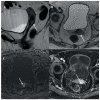Malacoplakia of the Uterine Cervix: A Case Report
- PMID: 33804212
- PMCID: PMC8000235
- DOI: 10.3390/pathogens10030343
Malacoplakia of the Uterine Cervix: A Case Report
Abstract
Malacoplakia is an uncommon chronic granulomatous inflammation that rarely affects the female genital tract. A case of a 78-year-old woman with malacoplakia involving the uterine cervix and the vagina is described. The patient complained of vaginal bleeding. Clinically, a 13-mm mass was detected in the cervix, which was confirmed by ultrasound scan and magnetic resonance imaging. Histological examination showed a dense histiocytic infiltrate with abundant Michaelis-Gutmann bodies involving the uterine cervix and the upper vagina. The presence of Escherichia coli was confirmed in the lesion by immunohistochemistry and polymerase chain reaction. Only 12 cases of cervical malacoplakia have been reported to date. This condition should be included in the differential diagnosis of cervical tumors.
Keywords: Michaelis–Gutmann bodies; inflammatory pathology; malacoplakia; uterine cervix.
Conflict of interest statement
The authors declare no conflict of interest.
Figures




References
-
- Michaelis L., Gutmann C. Ueber Einschlüsse in Blasentumoren. Ztschr. Klin. Med. 1902;47:208–215.
-
- Darvishian F., Teichberg S., Meyersfield S., Urmacher C.D. Concurrent malakoplakia and papillary urothelial carcinoma of the urinary bladder. Ann. Clin. Lab. Sci. 2001;31:147–150. - PubMed
Publication types
LinkOut - more resources
Full Text Sources
Other Literature Sources

